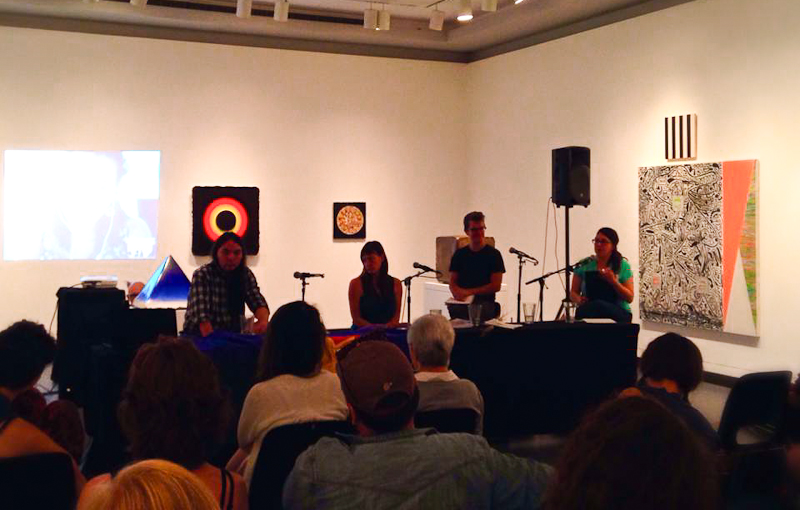
There was a hushed hustle through the doors into one of the rooms of the Ottawa Art Gallery on Aug. 23 for a free panel discussion on “Art as Resistance.”
Leah Snyder, moderator of the panel, is an Ottawa and Toronto-based artist, photographer and designer, as well as founding editor of the online magazine Mixed Bag Mag.
“It’s a magazine with a curatorial focus on the psychological spaces artists create that allow for deep cultural transformation,” Snyder said.
There were four panellists who all brought an object to base their presentation off of.
Scott Benesiinaabandan was up first. He is an inter-media artist and photographer residing in Montreal who is working on an international collaborative project with the UK and Ireland. The object he brought for the panel was a flag that was created in Derry, Northern Ireland.
The flag, the top half blue and the bottom green, with an eight-pointed star within a red circle in the middle. According to Benesiinaabandan it symbolizes the sky, the land, community and solidarity—more specifically a treaty relationship. The star is a frequently used symbol for infinity, he said.
“Any time we ran into a big, clean statue of the Queen, there was a world in her hands, and I feel strongly against that image,” and went on to explain how the photo on the ad for the panel discussion was one of him placing the flag over the hands of one of these statues.
Next up was Brown, an Ottawa-based artist who stages performative and sculptural intervention in public space and whose work celebrates process, labour, and DIY culture, according to Snyder.
Adam Brown held up a handful of tall reeds that grew from the deadened yard of his house. He documented himself nurturing the garden of this house back to a blossoming, beautiful state.
“It provides a counter narrative to the bureaucratic language of the municipal bylaw,” he said.
Third in line, via Skype, was Cairo -based artist and writer Amira Hanafi.
She moved to Egypt in 2010 to document the city of Cairo, but in 2011 the Egyptian revolution began.
The object she held up to the screen was composed of a collection of gas masks, which she said were approximately the equivalent of $2 because they were so commonly used by protesters like herself.
Hanafi worried about the political ramifications of working on her art, which could have then been misconstrued as propaganda or a statement. Instead, she said she focused on reading the news, reading history, reading theory, and participating in street protests.
While Hanafi admitted she felt guilty for not creating any art during this time, she said the demonstrations and protests she attended were, in fact, her artwork.
Emily Rose Michaud, a Montreal artist who focuses on urban ecology, then took the stand. Michaud took a sip from the object she brought for the panel—a mason jar filled with water from a Quebec lake.
She told the story of one of her projects to name all the Quebec waters, a street performance during which she dressed as a “fresh-water mermaid” in front of a table of mason jars, some filled with rocks, roots, and others simply with water from different regions of Quebec.
“Some people were delighted, enchanted by the idea of drinking water from this strange water-creature on the street and some people were like ‘I’m not drinking Meech Lake, no way,’” she said. “That was the point . . . to have them acknowledge their relationship with the water.”
Michaud ended the panel by restating the need to stop separating the categories of Art, Politics, and Life, asking the audience, “Why can’t they be a part of the living, breathing national interest?”





